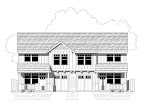Happy twenty-'leven from Istockhouseplans to all of our friends out there in cyberland. We hope your holiday was interesting and thoughtful. A quick note about our year-end report: despite the down economy, our books show that we made twice as much in 2010 as we did in 2009. Thanks to everyone who made that possible, and here's a toast to all of you that your books did and will do the same for 2011.
Now, to the topic at hand. A strange thing happened over the holidays. The building that we work from is heated with a forced air gas system, commonly known as a gas furnace. It was recently insulated and air-sealed. Somebody kicked a heat register shut and the tighter house acted differently. In this case something happened. Before, nothing would have happened. This lead us to a little investigation.
First off, a house is a closed system but not entirely. It is impacted by the outside environment to some degree. The more a house is insulated and air-sealed, the more you reduce the impact from and to the outside environment. This means you get more reaction within the house when something changes. What changed in this case was air pressure. By shutting a heat register, suddenly more blown air is directed to other registers. In a tight house, this air is supposed to balance by going into the return register, through the furnace where it is warmed, and back through the registers.
Now imagine that air that is blown into a bedroom can't return to the furnace. That is, it is blown in but there is no way for it to get out. This might be the case where there is carpet and the door is shut leaving a paper-thin space between the bottom of the door and the floor. A little air will get out but now the system will be imbalanced. Kind of like filling a balloon. More air goes in, but none comes out.
But the air has to go somewhere. With a balloon, it will stretch the environment. Unfortunately drywall is not as pliable as rubber. So the air goes where it can, that is through tiny cracks. At some point the room reaches critical mass for pressure. This is when things start to happen.
Much like a pipe that has been corked off, the air stops flowing through the duct. It might back up and force more air through another register up or down the line. If it is a dedicated duct run with no other outlets, it will back up into the furnace. So what you have is two pressurized environments doing battle. Try this: grab a straw and a loved one. Each of you put one end of the straw in your mouths. Now both blow as hard as you can. Cheeks will turn red, eyes will bulge, and finally someone will get a mouthful of the other one's air. This is called system failure.
In the case of your furnace you could simply blow a duct. However with today's tighter duct runs, the weak spot becomes the furnace, most notably the blower fan. So the fan has back pressure causing two forces to exert their will upon it. At some point the fan gives in and stops blowing. The furnace still warms but the forced-air part has been taken out of the equation. This tends to happen on the coldest day of the year on a Saturday night.
Granted, one single room is probably not going to have major adverse effects on the HVAC system. But imagine an 1800sf three bedroom house. The furnace is likely to be oversized (60kBtu) and the master bedroom might have two heat registers due to it's size (~200sf) as well as a heat register in the master bath and maybe one in the master closet. The door is closed and there is no appropriate 1" undercut. In fact, you would need about a 4" undercut. Air gets backed up in the room. Your head hurts. Then the furnace quits. You thought it was just the end of the cycle but it doesn't turn back on and the temperature continues to drop. At first you assume a power outage but the VCR clock is still blinking '12:00'. The next day it's even colder in the house so you call the HVAC tech. He says he'll be out there sometime between 9a and Friday.
The bugger is that your house was built last year.
Before buying a new house, ask if the system was properly sized. There are a slew of manuals and related software out there for professionals to use. As a builder, always ask your HVAC tech how they arrived at the necessity to install an 80kBtu furnace. Also ask how they are going to mitigate zonal pressure relief. If they stare at you or stutter or write it off, hire someone else.
In the meantime, Istockhouseplans recommends not using forced air systems. We push for hydronic floor heat, so called 'soft' heat (electric baseboard) and mini-split heat pumps. All of these systems take less space and use less or no air. They can also be sized more appropriately than a furnace can.
Don't forget to check your filters and consider cleaning your ductwork. Oh, and if your head hurts in your bedroom, simply try opening the door. Stay tuned for next time when we'll look at some more zonal pressure relief options.
Tuesday, January 4, 2011
Subscribe to:
Post Comments (Atom)






No comments:
Post a Comment